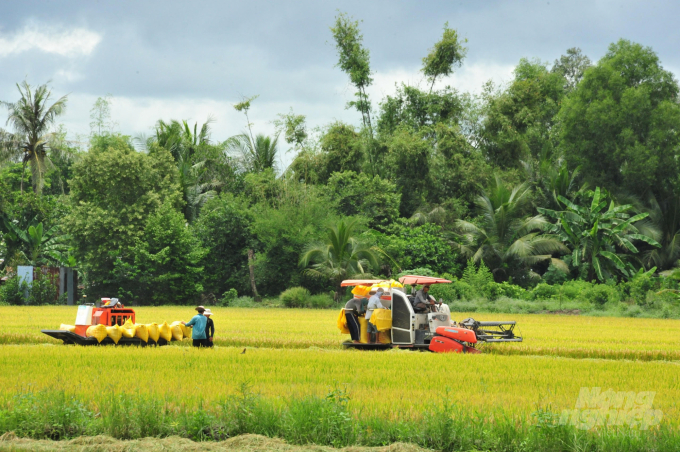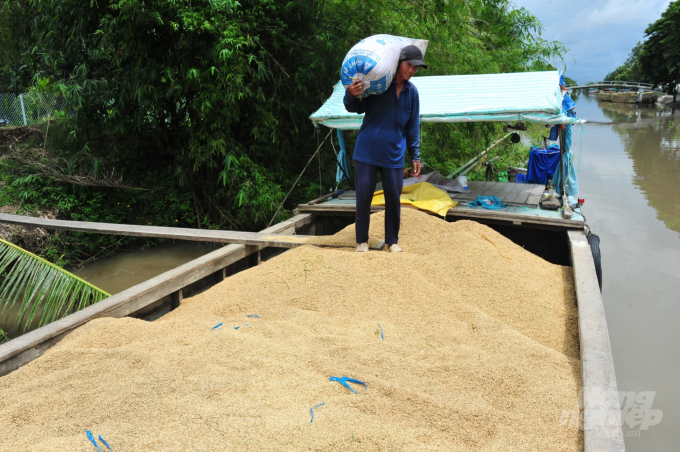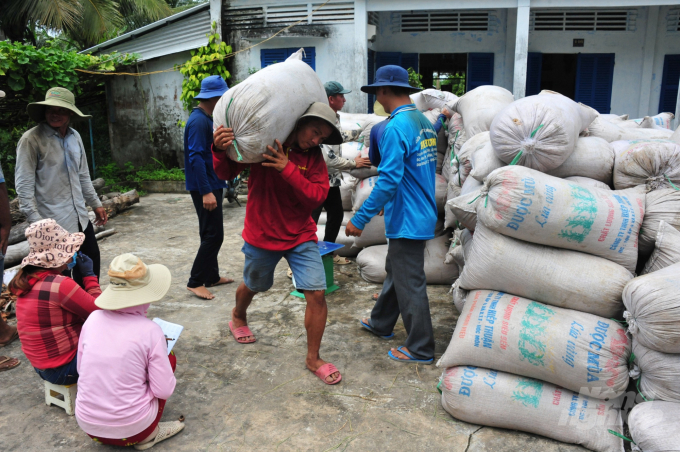May 21, 2025 | 03:34 GMT +7
May 21, 2025 | 03:34 GMT +7
Hotline: 0913.378.918
May 21, 2025 | 03:34 GMT +7
Hotline: 0913.378.918

Mechanisation of the harvesting process on the farm. Photo: LHV.
Statistic of the Department of Crop Production under the Ministry of Agriculture and Rural Development show that the rice-production area in the delta’s large fields reached about 160,000 ha in the winter crop of 2020-2021, a decrease of 10,000 ha compared to the winter crop of 2019-2020.
The department said the model of large field had been maintained and developed and the efficiency of rice production in the large fields associated with enterprises had increased.
But the area of large fields still accounted for a low percentage compared to the total rice-production area in the whole region, the department said.

Rice production in a large field in the Mekong Delta. Photo: LHV.
According to the calculation, local rice growers could earn an additional profit of VND 2.2-7.5 million (US$ 96-326) per ha while the production cost reduced 10-15 per cent and the output value increased by 20-25 per cent.
The ministry launched the model of large field since March, 2011 following the trend of association and businesses ensured the consumption for farmers.
In the summer-autumn crop of 2011, there were two provinces of An Giang and Ben Tre applying the model of large field for about 8,000 ha with the participation of 6,400 farming households.
Then, the delta had established many large fields with the area of over 19,700 ha in the winter-spring crop of 2011-2012.
There were over 100 enterprises signing offtake contracts for the large fields in the delta in the summer-autumn crop of 2014.

Mekong Delta in the rice-harvest season. Photo: LHV.
Accordingly, the successful contract performance increased from 30 per cent in 2013 to over 55 per cent in 2014.
The area of large fields in the delta reached about 140,000 ha in 2014.
The movement of applying the large fields were reportedly to strongly develop in the provinces of An Giang, Dong Thap and Soc Trang.
Only Can Tho City had applied the model of large field for 400 ha in the summer-autumn crop in Vinh Thanh District since 2011.
The city then planted 12 rice crops in 75 large fields, covering a total area of more than 17,600 ha with the participation of 12,500 farming households by the winter-spring crop of 2014-2015.
However, the number of enterprises co-operating with farmers following the model of large field has reached only 19 so far and the total area of large fields in the city has been less than 30,000 ha so far.
Similarly, in Soc Trang Province, they applied the model of large field for 40 ha in Truong Khanh Commune, Long Phu District since 2010 and achieved significant results at that time.
The province then operated 106 large fields with a total area of 12,000 ha in the winter-spring crop of 2012-2013.
However, the area of large fields has only reached under 17,000 ha until now.
There are still shortcomings during the production-linkage process that need to be fixed by authorised agencies and localities in the delta.
Le Thanh Tung, Deputy Director of the department said farmers collected rice following the centralised model and sold fresh rice to the enterprises.

Buying rice in the Mekong Delta. Photo: LHV.
Thus, the enterprises faced many difficulties in preparing vehicles to transport the fresh rice, he said.
The farmers had also not enough facilities to dry and store the rice, so harvested rice often had to be gathered at the field about 4-5 days before the company collects all, affecting to the quality of rice, he said.
Besides, there was no close link between farmers and enterprises, he added.
Although there was a purchase contract between farmers and enterprises, farmers still sold to outside traders if the enterprises did not buy the rice in time, he said.
It meant that there was lack of an appropriate legal framework for fixing disputes between farmers and enterprises, especially, the contract of production and consumption of products between enterprises and farmers, he said.
Specifically, the contract signed with the farmer was believed to be unclear, there was still no agreement on the location of the rice collection, the humidity, the impurity, as well as lack of sanctions when the relevant parties did not perform the contract properly, he said.
Tung said in order to promote efficiency in applying the model of large field, the delta should flexibly apply mechanisms and policies, invest resources, strengthen linkages in chain production and improve product quality through linkages such as cooperatives, he said.
Especially, it needed to enhance linking farmers with enterprises in processing, consuming products and supplying inputs for production, he said.
It was also necessary to improve the management role of the linkages’ management board to urge members of the production model to strictly perform the offtake contract, he said.

(VAN) Japan's grant aid project contributes to capacity building, promoting organic agricultural production, and fostering sustainable community development in Dong Thap province.

(VAN) For years, the CRISPR-Cas9 genome technology has been reshaping genetic engineering, a precision tool to transform everything from agriculture to medicine.

(VAN) Vietnam aims to become a 'leader' in the region in the capacity and managing effectively soil health and crop nutrition.
![Reducing emissions from rice fields: [Part 1] Farming clean rice together](https://t.ex-cdn.com/nongnghiepmoitruong.vn/608w/files/news/2025/05/05/z6509661417740_a647202949c539012a959e841c03e1d3-nongnghiep-143611.jpg)
(VAN) Growing clean rice helps reduce environmental pollution while increasing income, allowing farmers to feel secure in production and remain committed to their fields for the long term.
/2025/05/19/5136-1-144800_230.jpg)
(VAN) The Nghe An Provincial People's Committee has just approved the list of beneficiaries eligible for revenue from the Emission Reductions Payment Agreement (ERPA) in the North Central region for the year 2025.

(VAN) 14 out of 35 domesticated elephants in Dak Lak province have had their living conditions improved, with 11 of them currently participating in the non-riding elephant tourism model.

(VAN) Muong Nhe Nature Reserve hopes that being upgraded to a national park will lay the foundation for forest protection efforts to be carried out in a systematic, modern, and sustainable manner.